Pre-Implementation Activities
Guidance for Teaching Section 4: Implementation
Who Should Teach and Learn These Topics
Only instructors with substantial experience teaching and implementing TeamSTEPPS across an organization or units should use the material in section 4: Implementation. Ideally, multiple trainers should lead trainings discussing readiness assessment, measurement, implementation planning, coaching, and change management to capitalize on a broader range of expertise and experiences than any one trainer can have.
Frontline staff will benefit from learning the four core training modules. The people most likely to benefit from learning about measurement, implementation planning, coaching, and change management are those with more-specific roles:
- People likely to lead an implementation effort in their organization or unit,
- People planning to teach TeamSTEPPS to others,
- People who may function as formal or informal coaches for other staff, or
- Leaders preparing to use TeamSTEPPS to foster culture change in their organizations.
Generally, people being taught implementation materials are more experienced than other trainees. The difference between making the implementation training productive or unproductive will depend on the level of trainee expertise and their prior experiences in implementation and in training others.
How These Topics Should Be Taught
The start of section 2 in each of the four TeamSTEPPS modules provides general suggestions related to effectively teaching TeamSTEPPS. People preparing to lead implementation or change management efforts in their organization or those who coach others are assuming responsibilities that will require substantial preparation and effort. Ask the people who will be trained on the materials related to implementation to review the materials before the training. If they cannot or are unwilling to do so, they're unlikely to succeed in the roles they are being trained for.
While a basic set of overview slides has been created for the content discussed in section 4, these slides are not designed to support didactic lectures related to the content. Discussion and exercises to illustrate the content are more effective approaches for achieving deeper learning. Training options for teaching the content of section 4 include:
- For each major topic, ask a series of discussion questions. You may include the entire group or have smaller teams develop their own answers and report out to the whole group.
- What was the most important insight about this topic?
- What about the topic did you not totally understand?
- What actions related to the topic will be the most challenging for you in your organization or unit?
- How can you involve patients in these activities?
- For each process, offer a hypothetical scenario and ask groups to discuss and report out on how they would follow the process. You can either create a scenario that reflects the backgrounds and needs of training participants or have each group create their own scenario. For more extended processes, have different teams focus on different steps in the process.
- Ask participants to share stories directly related to the topics you are discussing. A set of story prompts is provided below:
| Topic | Prompt | Purpose |
|---|---|---|
| Readiness Assessment | Tell about a time you tried to make a change, but the organization wasn't ready. | Reinforce the need for assessing readiness. |
| Levels of Measurement | Give an example of when short-term learning failed to lead to long-term behavior change. | Reinforce the importance of evaluating longer term change. |
| Change Teams | Share what you've learned about creating a successful Change Team. | Encourage thought about selecting the right people. |
| Sustainability | Describe an initiative your organization didn't sustain and say why. | Reinforce the challenges of sustainability and importance of preparing for it. |
| Coaching | What makes some coaches effective and others unhelpful? | Reinforce the traits of effective coaches. |
| Change Management | Think of organizational changes that got traction and those that failed. | Help clarify strategies likely to enable TeamSTEPPS to be sustained after initial implementation. |
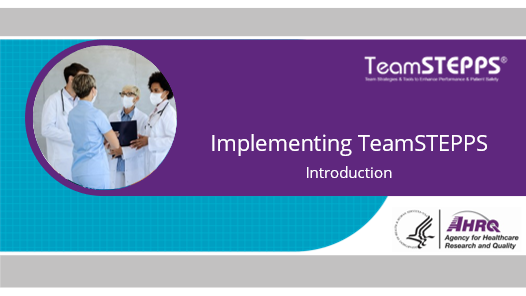
Slide 1, "Implementing TeamSTEPPS," can be displayed at the start of the training as people enter the virtual or onsite training
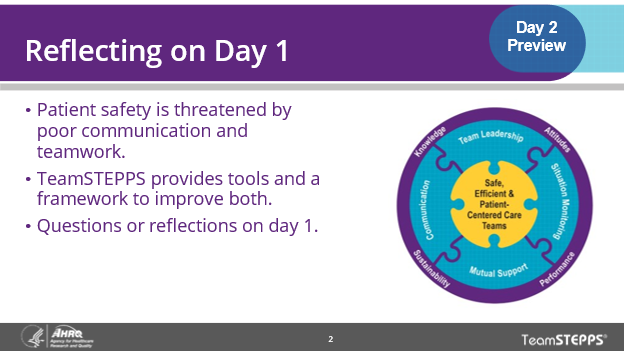
Display Slide 2, “Reflecting on Day One,” as you elicit reactions to the first day of training. Encourage the participants to reflect on what they learned during day 1. Asking participants what their goals are for day 2 may encourage active listening and alert the trainer to specific topics trainees are particularly interested in.
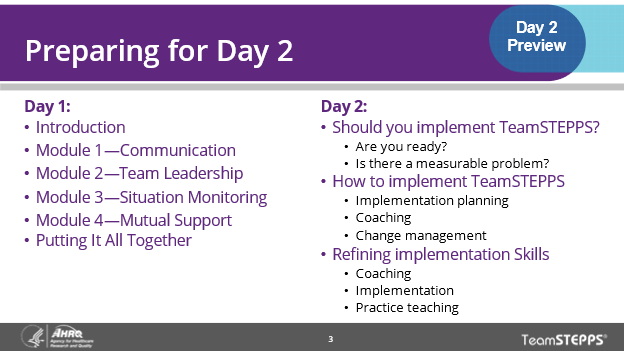
Slide 3, "Preparing for Day Two," can be used to introduce the agenda for the day. You may want to note when breaks are planned or even insert them into a version of this slide.
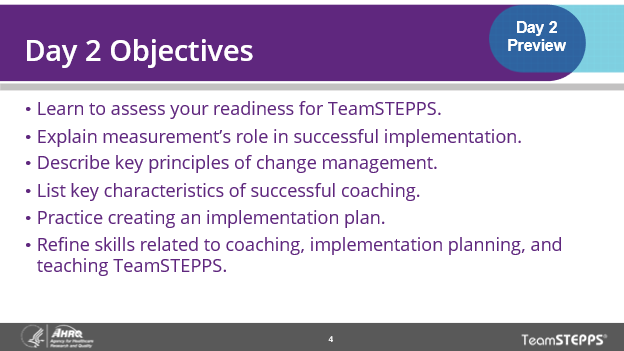
Review Slide 4, "Day Two Objectives"; save time by displaying the slide without orally reviewing each objective. Stress the broad goal of acquiring insights and tools that will support the participants' efforts to successfully implement and sustain TeamSTEPPS in their organization. Objectives include:
- Learn to assess your readiness for TeamSTEPPS.
- Explain measurement’s role in successful implementation.
- Describe key principles of change management.
- List key characteristics of successful coaching.
- Practice creating an implementation plan.
- Refine skills related to coaching, implementation planning, and teaching of TeamSTEPPS.
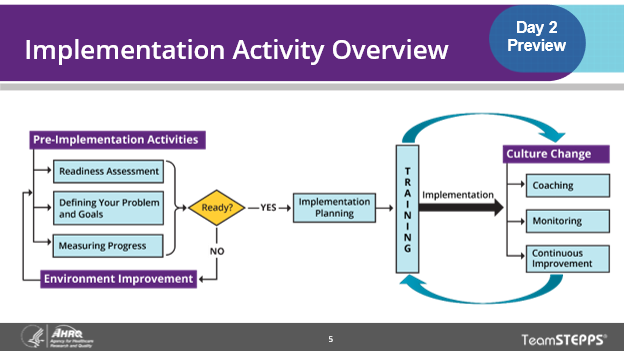
Present Slide 5, "Implementation Activity Overview"; explain that it’s important to understand how all the implementation activities discussed in the training fit together and how some of these activities depend on and reinforce others. Using the slide’s graphic, note the relationships between pre-implementation activities, planning, and active implementation and sustainability.
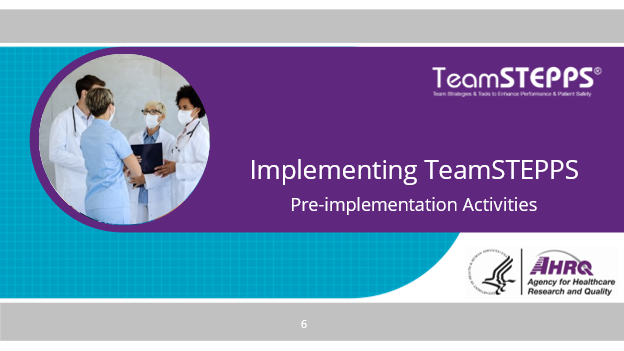
Present Slide 6, "Implementing TeamSTEPPS: Pre-Implementation Activities"; use this slide to make the transition to a discussion of the first set of implementation activities.
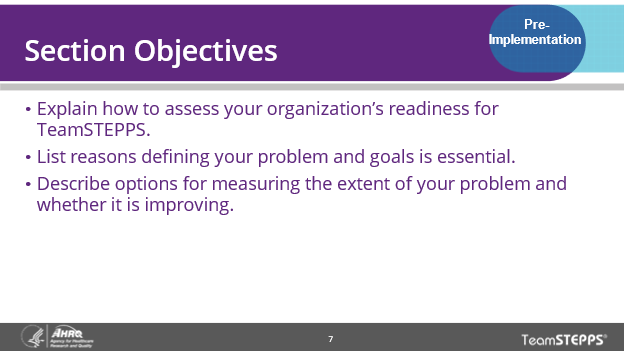
Review Slide 7, "Section Objectives"; save time by displaying the slide without orally reviewing each objective. Objectives include:
- Explain how to assess your organization’s readiness for TeamSTEPPS.
- List reasons defining your problem and goals is essential.
- Describe options for measuring the extent of your problem and whether it is improving.
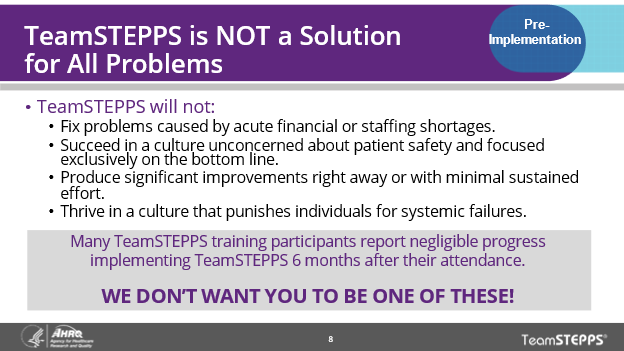
In displaying Slide 8, "TeamSTEPPS is NOT a Solution for All Problems," note that TeamSTEPPS is sometimes introduced in situations where it is unlikely to be successful. Help participants appreciate that while TeamSTEPPS can provide many benefits, it is not a solution for all organizational challenges in healthcare.
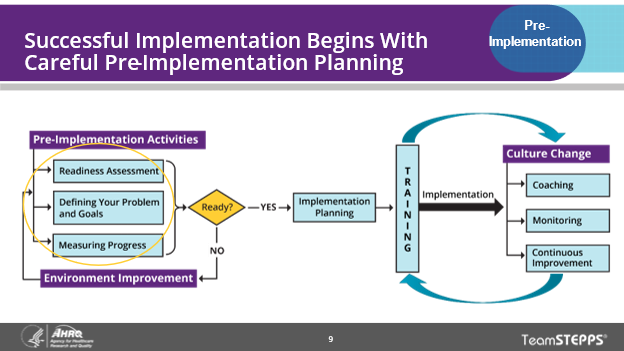
Present Slide 9, "Successful Implementation Begins With Careful Pre-Implementation Planning"; quickly review the three pre-implementation activities. Explain that some of these activities (like measurement) will begin in this phase and continue during and after TeamSTEPPS training and initial implementation.



